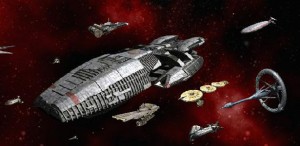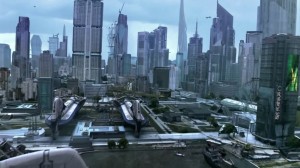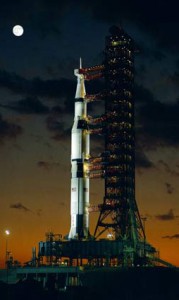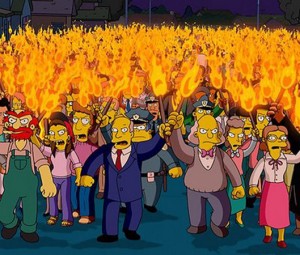Sins of the Children: Caprica
Sunday, September 20th, 2009by Calvin W. Johnson
Today I have the pleasure of hosting my friend Calvin W. Johnson, who will give us his thoughts on Battlestar Galactica and Caprica. Dr. Johnson is Professor of Physics in San Diego State University where he does research in computational quantum mechanics. He’s also an author with poems and SF stories in many venues, including Analog and Asimov’s.
 One of the earliest and most lasting narrative models in science fiction is Frankenstein. The recent SciFi channel reboot of Battlestar Galactica owes itself as much to Mary Shelley as to the original 1978 television series. In the original, the robotic Cylons are creations and inheritors of a now-extinct reptilian race; in the 2003 reboot, the Cylons are our own creation. Like Frankenstein’s creature (in the novel), the reimagined Cylons are as capable of tormented philosophical reasoning as they are of homicidal rage.
One of the earliest and most lasting narrative models in science fiction is Frankenstein. The recent SciFi channel reboot of Battlestar Galactica owes itself as much to Mary Shelley as to the original 1978 television series. In the original, the robotic Cylons are creations and inheritors of a now-extinct reptilian race; in the 2003 reboot, the Cylons are our own creation. Like Frankenstein’s creature (in the novel), the reimagined Cylons are as capable of tormented philosophical reasoning as they are of homicidal rage.
It is the Cylons’ self-doubt that saves the human race from extinction, which is lucky considering the forty thousand surviving humans are so flawed and back-biting that a brace of ambitious bonobos armed with a bottle of window cleaner and some lead-tainted Mexican candy could have wiped them out. In current parlance Battlestar Galactica was “dark,” a quality currently all the rage (see also: Christopher Nolan’s two Batman movies). The first two seasons frequently had brillia nt writing and acting, but by the final season Battlestar Galactica (or BSG to its friends) deteriorated into a self-parodying soap opera. We were told at the beginning of episodes that the Cylons “have a plan,” but it became increasingly clear that creator Ron Moore was making it up as he went along; by the series finale he had written the reboot’s most compelling creation, Kara “Starbuck” Thrace, into such a corner that he could only end her story by having her melt into the wind like an bad odor.
nt writing and acting, but by the final season Battlestar Galactica (or BSG to its friends) deteriorated into a self-parodying soap opera. We were told at the beginning of episodes that the Cylons “have a plan,” but it became increasingly clear that creator Ron Moore was making it up as he went along; by the series finale he had written the reboot’s most compelling creation, Kara “Starbuck” Thrace, into such a corner that he could only end her story by having her melt into the wind like an bad odor.
But Battlestar Galactica was the best thing going on the SciFi channel. Ominously, and not in a good way, the Powers That Be agreed to a prequel, Caprica, set 58 years “before the fall.” Caprica details the story of how the Cylons were created and how humanity sowed the seeds of its own destruction. (Warning: mild spoilers ahead).
Caprica takes us back to a shinier, happier time to meet Zoe Greystone, the 16-year-old scion of a cybernetics corporation. Part genius, part whiny goth girl, part secret religious fanatic (a monotheist in a world of polytheists), she is killed off in the first few minutes. Eventually, she is resurrected cybernetically, much to the regret of everyone, herself included.
If this sounds familiar, why yes it is, even more so than Frankenstein. When one thinks of a prequel written in response to a successful, gritty science fiction phenomenon, one can only invoke…
Star Wars.
The parallels are uncanny.
Recall: in the Star Wars prequels, Lucas takes us back to a shinier, happier time, to meet Anakin Skywalker, a technologically brilliant yet whiny child who secretly falls in with the sinister cult of the Sith, is nearly killed, then resurrected in a cyborg body to terrorize the galaxy.
Wow. I get goosebumps just thinking about the parallels, and not in a good way.
 Caprica is far better than The Phantom Menace, but that is a low bar, and neither is Caprica as compelling as the opening Battlestar Galactica miniseries. We are supposed to sympathize with Zoe’s grieving father, a Bill Gates-like character, but his distance from wife and work also distances him from the audience. Much more intriguing is Joseph Adams, a well-dressed lawyer who lost his wife and daughter in the same bombing that killed Zoe, and who is attempting to reconnect with his young son William, all the while in a dangerous dance with a Mafia-like gang from his Tauron homeworld. Young William, of course, grows up to be Bill Adama, who helps to save the human race 58 years later as captain of the Galactica. The Adama drama is much more compelling than the dull Frankenstein, I mean Greystone, family but is curiously underplayed here despite a few dramatic scenes.
Caprica is far better than The Phantom Menace, but that is a low bar, and neither is Caprica as compelling as the opening Battlestar Galactica miniseries. We are supposed to sympathize with Zoe’s grieving father, a Bill Gates-like character, but his distance from wife and work also distances him from the audience. Much more intriguing is Joseph Adams, a well-dressed lawyer who lost his wife and daughter in the same bombing that killed Zoe, and who is attempting to reconnect with his young son William, all the while in a dangerous dance with a Mafia-like gang from his Tauron homeworld. Young William, of course, grows up to be Bill Adama, who helps to save the human race 58 years later as captain of the Galactica. The Adama drama is much more compelling than the dull Frankenstein, I mean Greystone, family but is curiously underplayed here despite a few dramatic scenes.
The technology of Caprica is not only flashier but also significantly more advanced than in Battlestar Galactica; I suppose the First Cylon War seriously knocked civilization back on its heels. Among the advance is a kind of virtual reality; I tend to despise virtual reality stories on principle, although here the stupid factor is significantly less than Star Trek holodecks or The Matrix, again low bars (I realize such a statement is hate-mail bait). Oddly enough, the tech I liked the best was a kind of smart paper; less dramatic but much more realistic.
BSG, as does all science fiction, provided a platform to play out current anxieties: terrorism, genocide, abortion, religion. It’s clear that Caprica will touch upon at least two major themes: the tension between heritage and assimilation among immigrants facing bigotry, and religion. Most discussions about religion in science fiction are ill-informed and inane, and have none of the critical depth or insight found in, say, Life of Brian or South Park. In both BSG and Caprica, however, the religion proxy discussion is more intriguing, mostly because the writers allow the characters the sincerity of their beliefs or, better yet, realize the insincerity of all our beliefs and non-beliefs.

Watching Caprica I was struck when one character, questioning the monotheism of another, asks: do you really want to believe in a universe run by a single God who gets to decide what is right and what is wrong, with no recourse, no appeal? In other words: polytheism as the ultimate checks-and-balances for governing the universe. For science fiction, this counts as a deep insight.
The pilot for Caprica was released as a DVD and download in April; it is set to premiere as a series in early 2010. It’s unlikely to be as awful as spinoffs often are — for example, I couldn’t even bear to try the Stargate: Atlantis spinoff from SG-1 — but I am not holding my breath. In fact, I’ll probably wait for the DVD.


 Two articles of mine appeared today in very different venues.
Two articles of mine appeared today in very different venues.

